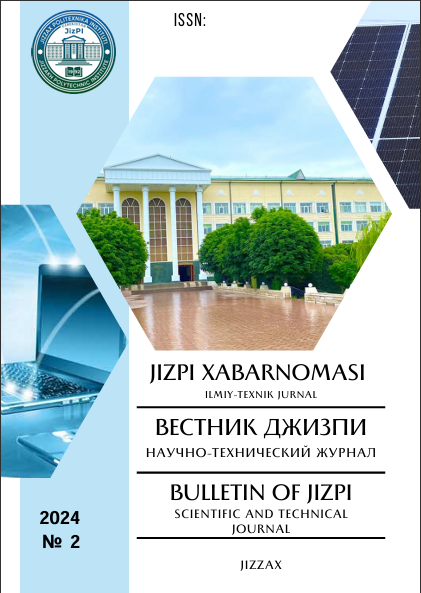ОПТИМИЗАЦИЯ МЕХАНИЗМОВ ОРГАНИЗАЦИИ ПРИГОРОДНЫХ ПАССАЖИРСКИХ ПЕРЕВОЗОК
Keywords:
пассажирский комплекс, пригородные перевозки, пассажирские перевозки, государственное регулирование, транспортное предприятиеAbstract
В статье рассмотрены методики управления пассажирскими перевозками в пригородных перевозках. Проведен SWOT-анализ который показал основные направления развития пригородных пассажирских перевозок. Определен механизм управления пригородными пассажирскими перевозками, координированный и контролируемый государством. Разработана схема механизма управления пригородными пассажирскими перевозками.Сформулированы предложения по оптимизации транспортных услуг, которые базируются на функционировании механизма организации пассажирскими
перевозками в пригородном сообщении.
References
1. Ходжаев Б.А. Основы автомобильных грузовых и пассажирских перевозок.
-Ташкент: Изд-во Узбекистан, 2002 – 239 с. ISBN 5-640-03132-8
2. Daraio, Cinzia & Diana, Marco & Di Costa, Flavia & Leporelli, Claudio &
Matteucci, Giorgio & Nastasi, Alberto. (2015). Efficiency and effectiveness in the urban
public transport sector: A critical review with directions for future research. European
Journal of Operational Research. 248. 10.1016/j.ejor.2015.05.059.
3. Fitzová, H., Matulová, M. & Tomeš, Z. Determinants of urban public transport
efficiency: case study of the Czech Republic. Eur. Transp. Res. Rev. 10, 42 (2018).
https://doi.org/10.1186/s12544-018-0311-y
4. Irina Ulitskaya, Julia Vasilyeva, Elena Telushkina, Svetlana Glagoleva,
Development of the logistics system of urban public passenger transport, Transportation
Research Procedia, Volume 63, 2022, Pages 2857-2865, ISSN 2352-1465,
https://doi.org/10.1016/j.trpro.2022.06.332.
5. Brons, M., Nijkamp, P., Pels, E. et al. Efficiency of urban public transit: A meta
analysis. Transportation 32, 1–21 (2005). https://doi.org/10.1007/s11116-004-0939-4
6. Dawda, N. H., Gajera, H., Joshi, G. J., Arkatkar, S. S., & Dave, S. K. M. (2021).
Efficiency Based Evaluation of Public Transport and Paratransit Systems with a View
to Integrating Transportation. Transportation Research Record, 2675(3), 17-
32. https://doi.org/10.1177/0361198120980322
7. Canitez, F. (2018). Urban public transport systems from new institutional
economics perspective: a literature review. Transport Reviews, 39(4), 511–530.
https://doi.org/10.1080/01441647.2018.1552631
8. Amirah, Nur & Mohamad, Diana & Hilmy, Ahmad. (2021). Acceptable walking
distance accessible to the nearest bus stop considering the service coverage.
10.1109/ICOTEN52080.2021.9493435.
9. Mauro, Raffaele. (2015). Traffic and Random Processes: An Introduction.
10.1007/978-3-319-09324-6.
10. Oded Cats, Zafeira Gkioulou, Modeling the impacts of public transport reliability
and travel information on passengers’ waiting-time uncertainty, EURO Journal on
Transportation and Logistics, Volume 6, Issue 3, 2017, Pages 247-270, ISSN 2192-
4376, https://doi.org/10.1007/s13676-014-0070-4.
11. Yevhen Tkhoruk, Olena Kucher, Mykola Holotiuk, Mykhailo Krystopchuk and
Oleg Tson, ―Modeling of assessment of reliability transport systems,‖ in Proceedings
of ICCPT 2019, Ternopol, 2019, pp. 204–210.
12. Choi, Bong & Kim, Bara & Chung, Jinmin. (2001). M/M/1 Queue with Impatient
Customers of Higher Priority. Queueing Syst.. 38. 49-66. 10.1023/A:1010820112080.
13. Peter van der Waerden, Jaap van der Waerden, Michiel Burger, Exploring the
role of public transport service and walking route related factors to identify maximum
walking distances to bus stops in the Netherlands, Journal of Public Transportation,
Volume 26, 2024, 100096, ISSN 1077-291X,
https://doi.org/10.1016/j.jpubtr.2024.100096.
14. Asefeh Hasani Goodarzi, Eleen Diabat, Armin Jabbarzadeh, Marc Paquet, An
M/M/c queue model for vehicle routing problem in multi-door cross-docking
environments, Computers & Operations Research, Volume 138, 2022, 105513, ISSN
0305-0548, https://doi.org/10.1016/j.cor.2021.105513.
15. Fadyushin, А. (2022). Methodology for determining the optimal parameters of a
public transport stop point. Intellect. Innovations. Investments. 6. 124-134.
10.25198/2077-7175-2022-6-124.


